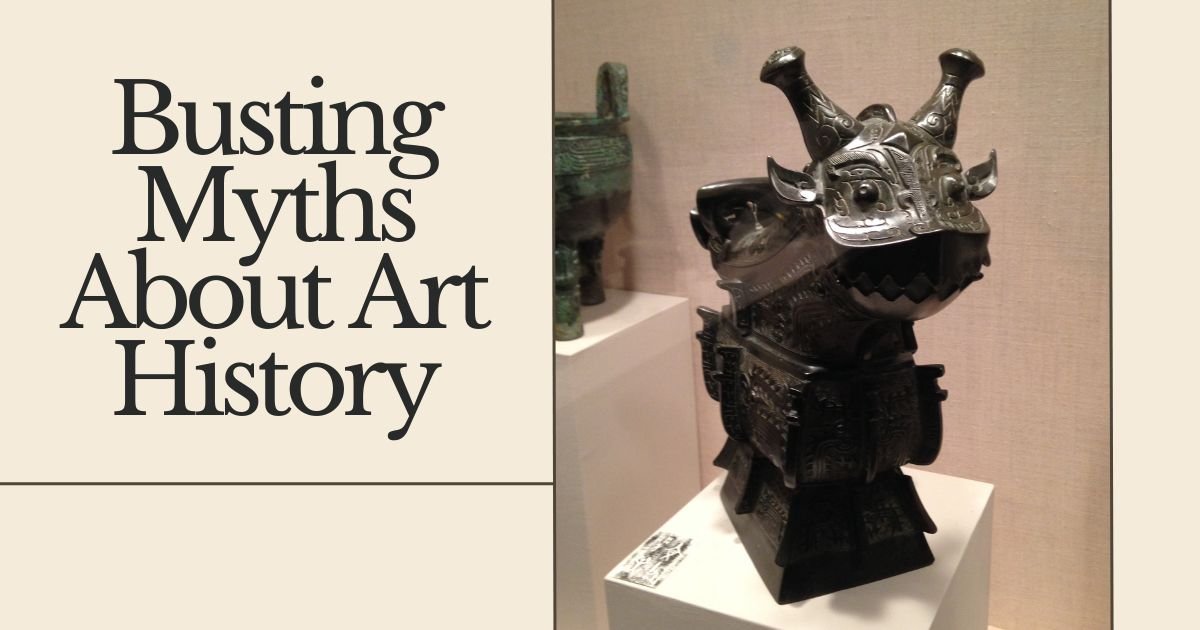This little guy in the cover image has heard some crazy stories about being an art historian, and he wants to know if they are true. Chinese bronze pouring vessel with dragon-headed lid. Western Zhou Dynasty (11th century BCE). Princeton University Art Museum. Photo by A Scholarly Skater.
I encounter these common myths and misconceptions often when I tell people about my work. Some are understandable mistakes, while others come from prejudices about what kinds of college degrees are worth having. I’ll aim to debunk them all today.
Myths debunked
- Art historians don’t get paid to look at art all day. I wouldn’t really mind if this were true, but it’s not. Looking at and reading about art is a big part of our jobs, but we do a lot more than just that. In fact, what we do can be really hard work.
- Art historians are not (necessarily) collectors. Although their abiding appreciation for art might seem to suggest a desire to own it, many art historians (including myself) don’t collect. To me, at least, knowing that most of my favorites have already found their forever homes in museums would take much of the fun out of it. Plus, art collecting is an expensive hobby, but art history is not a lucrative field.
- Art historian is not another word for artist. This is the misunderstanding I encounter most frequently. “You studied art history? You must be really good at drawing.” Not at all. I’m actually pretty bad at it. Art history and art making are two separate fields. Although I know several people who’ve pursued both, many more have chosen one or the other. By taking art classes, I’ve developed a new appreciation for the skill involved in creating works of art, but I don’t actually have that skill.
- Art historians are not publicists for artists. Some artists seem to think I should use my skills to promote their work. They often request that I feature them on my website or submit an article about them to a newspaper. I don’t like being asked this, and I always say no. If I feature someone on my website, it’s exclusively because I enjoy their work and think my readers will find it interesting. Similarly, I don’t submit articles for publication if I have a monetary interest in the subject. However, I’m happy to help an artist with their biography or to write a press release for a gallery, as long as I’m not asked to take a biased or distorted point of view. Other art historians may have different points of view, particularly those working for on the commercial side, but the main point here is that “art historian” does not equal “publicist for artists”.
- Most art historians aren’t appraisers. Appraisal means assigning market value to an object. Art historians are certainly good candidates to become fine art appraisers, but most don’t pursue this avenue, which requires special training. In fact, many art historians never deal with the art market in their work, so they rarely think about how much an object is worth. While we’re on the subject, appraisal isn’t a party trick. An appraiser won’t spent five seconds looking at the painting above your fireplace and then magically give you a dollar value. Besides the fact that an accurate appraisal takes time, giving any sort of appraisal is a serious thing because it carries legal liability. So, please don’t put an appraiser or other art expert on the spot.
- There are plenty of careers for art historians. People tend to think that museum curator and university professor are the only jobs you can get with an art history degree, but they are actually just two of many possible career paths for art historians.
- An art history degree is far from useless! This is the number one art history myth I wish I could end forever. Even though art history may not present as many high-earning career opportunities as some other majors, there’s still plenty of value to be gained from it. Many of my art history classmates are not actually working in museums or galleries; they’re instead thriving in other careers, with the help of the skills they learned through art history. You can learn about the value of an art history degree in one of my other posts.


